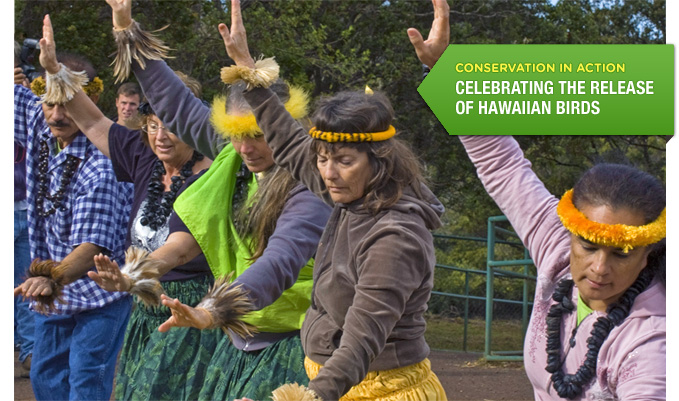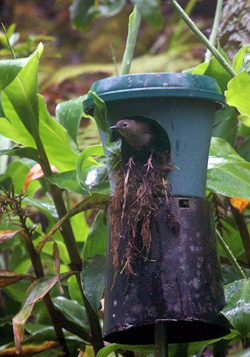|

The Kauai Forest Bird Recovery Project and San Diego Zoo Global's other conservation partners turned out to celebrate an upcoming release of 22 puaiohi. A beautiful mele, or song, along with chants, dances, and drumming were performed to bless this event. (Photo by Michael Teruya)
Dear Friend,
 A wild puaiohi leaves an artificial nest box, which helps protect it from predators. (Photo by Mitch Walters)
A wild puaiohi leaves an artificial nest box, which helps protect it from predators. (Photo by Mitch Walters)
Not every endangered bird release is commemorated by a ceremonial event like the one held on February 20 for the puaiohi, or small Kauai thrush. Singers and dancers from a Hawaiian cultural center on Kauai, the Ka ‘Imi Na‘auao O Hawai‘I Nei Institute, led the celebration in Kokee State Park to mark the upcoming release of 22 captive-bred puaiohi into the Alakai Wilderness Preserve. Hosted by the Kauai Forest Bird Recovery Project, it was all part of ongoing efforts to save the species from extinction: these wonderful songbirds are a unique part of Kauai's natural and cultural heritage.
The puaiohi happens to be one of several species of endangered forest birds found only on Kauai. While the islands are often described as paradise, small birds like this are threatened by rats, poor habitat degraded by wild pigs and goats, and mosquitoes carrying avian malaria and pox. When we realized that perhaps as few as 200 puaiohi survived in the wild, back in 1996,
San Diego Zoo Global partnered with the U.S. Fish and Wildlife Service, the Hawaii Division of Forestry and Wildlife, and others to save the species.
After 15 years of intensive hatching and hand rearing at our Keauhou and Maui Bird Conservation Centers, San Diego Zoo Global's Hawaii Endangered Bird Conservation Program began reintroducing puaiohi into the Alakai Wilderness Preserve in 1999. We can happily announce a true milestone, because with this upcoming 14th release, 222 puaiohi will have been reintroduced into the wild—possibly more than the number existing in the wild when the recovery efforts began!
Of course, captive breeding alone can't prevent the puaiohi's extinction. Wild population surveys are important as well as habitat management, legal protection, and public awareness campaigns that extend to Hawaii's schools, so local communities can be good stewards of endangered wildlife. What is heartening is how much Hawaiians here want the puaiohi to survive and thrive. On this day of celebration their songs and dances invoked the protection and goodwill of the gods and elders for the birds and their habitat as well as for the biologists who work to conserve them. One lovely poetic song, or mele, written especially for this event, directly addresses the puaiohi and blesses the release.


Best regards,
San Diego Zoo Global Wildlife Conservancy Team
wildlifeconservancy@sandiegozoo.org
|